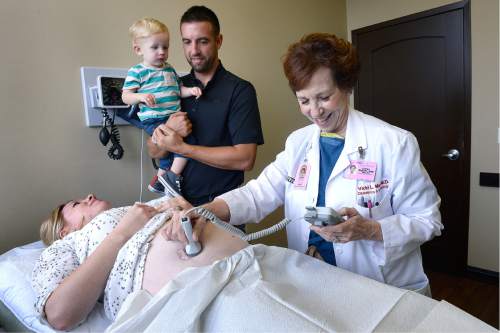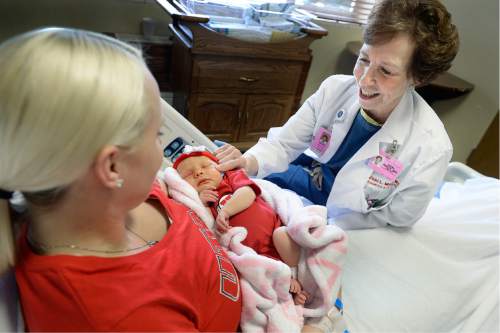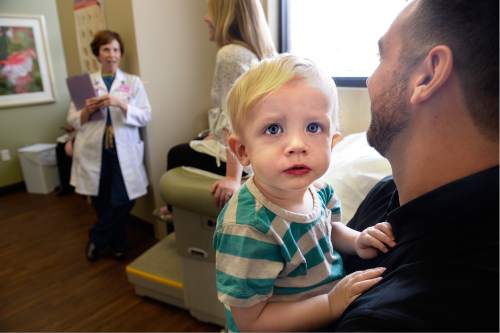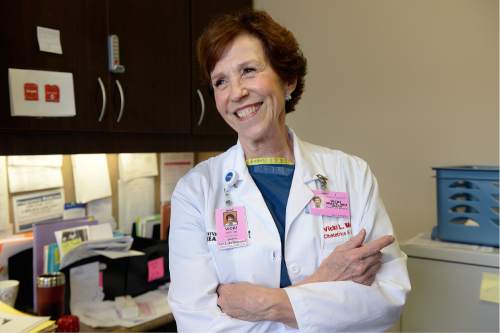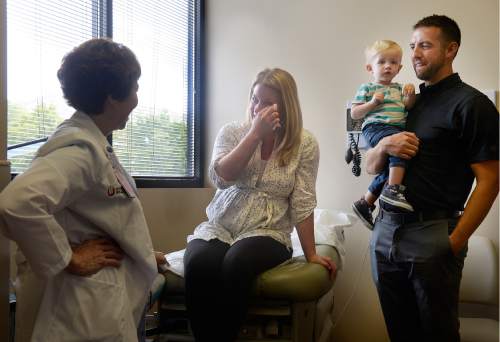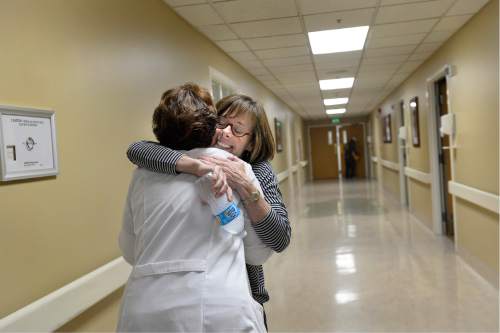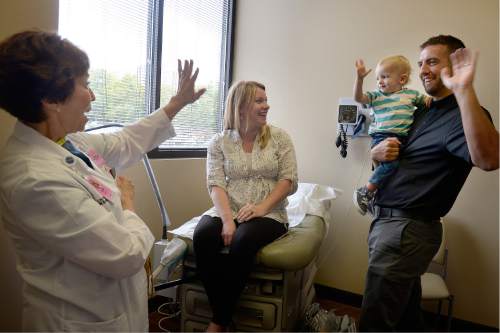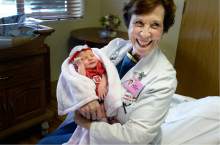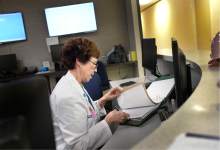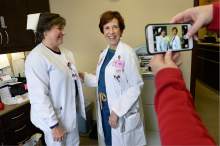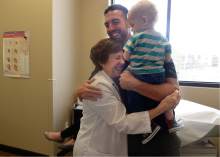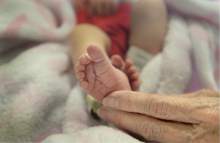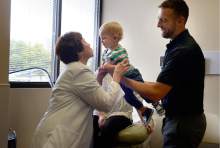This is an archived article that was published on sltrib.com in 2015, and information in the article may be outdated. It is provided only for personal research purposes and may not be reprinted.
A faint shade of pale was the first sign of catastrophe after a patient named Jolene gave birth to her second child.
Obstetrician Vicki Macy remembers glancing up to see the postpartum mom holding her newborn daughter. Something did not look right.
Others have called it Macy's "sixth sense" — the ability to notice distress in a patient before the patient herself can describe it. For Macy, it is more of a gift from her three decades of experience in obstetrics: When her intuition sounds the alarm, it usually springs from something concrete — an unfocused gaze, a weakness of voice. The initial signs that Jolene's uterus had ruptured during labor and was hemorrhaging critically could be explained by the normal exertion of having a baby.
But she was too pale.
Recognizing the difference, Macy says, is the "art of medicine" — a phrase Macy could not imagine herself saying in 1985, when she became the first woman to complete the University of Utah's obstetrics residency program and one of the first female OB-GYNs in the state. She has delivered 9,000 babies in Utah, including multiple generations of some families.
She recently left her practice at LDS Hospital and has moved to Ellensburg, Wash., where she and her husband are enjoying their new ranch and she, at 71, is the lone OB in a women's clinic.
—
'My one shot' • Just to be considered for medical school in 1974 as a 30-year-old mother of two, an admissions officer at the University of Oregon told Macy, she'd have to go back to undergraduate courses "so the committee can see if your brain still works."
It did.
"I went that whole year, plus the summer, and finished all the classes that he suggested I finish. I did very well. I had done well when I was an undergraduate as well. But not quite as well as when I was really focused and thought, 'This is my one shot.'"
Macy said she had wanted to be an obstetrician since fourth grade, but by college, teaching seemed a better fit for a wife and mother. Then, several years after she graduated from college, she read a magazine article about a mother of nine who finished medical school at age 52.
"That lit my fire," Macy says. "I thought, if she could do that at her age, I should be able to do it because I was only like, 30."
After medical school, she "fell in love with" the U.'s OB residency program.
Being the only woman among 16 students in the program saddled Macy with unusual expectations; two previous female residents had left the program without finishing in recent years, and Macy knew she was considered a bit of a gamble.
After her residency, in her early years as a practicing doctor, she confronted more doubts that a woman could be a suitable obstetrician. After practicing for one year in Bozeman, Mont., Macy returned to Salt Lake City and joined Mary Beard, another OB-GYN, in trying to start the Salt Lake Valley's first women's health center to be staffed by women. They asked for a loan and received it — but not before the men behind the money said, "You know, we don't know whether this will even work, but we're willing to help you try."
"There was a feeling at the time you weren't going to be as good as a man," she said. "I worked really, really hard to never have somebody say, 'She doesn't pull her weight.' I probably overworked trying to never have one of the men say, 'Well, I wouldn't want her on my team, she won't do the extra thing. If we need help, she never volunteers.'"
—
'This is different.' • Even her patients initially were "a bit hesitant" to trust a female doctor, she says — a far cry from modern practice. Since 1985, 95 women have completed the U.'s residency program in obstetrics. More than 80 percent of the nation's OB-GYN residents were women in 2010, the most recent year for which the Association of American Medical Colleges has data. In a 2012 review by the journal Patient Education & Counseling, researchers found studies consistently showed patient preference for female OB-GYNs, who were perceived to have a more "patient-centered" communication style, with more "emotional talk" and "psychosocial counseling."
But Macy says that was not her strength at the start of her career. For example, she recalls starting with a much narrower view on how women should handle childbirth.
"I remember being horrified when I first went [to Utah] on my residency, how many people had epidurals," she said. "I delivered my babies without any medication, so I thought everyone else could do this ... if they'd get their mind in the right place. ...As you work with people more, you appreciate the differences in people's tolerance for pain and frightening situations they haven't been in before. Whatever makes you happy, as long as you're safe. The trial by fire wasn't obligatory to be a woman."
Macy said she also learned quickly that her patients' stress and exhaustion in labor could impact their progress toward delivery. She recalled a patient in her first year of practice who was so tense that her labor wasn't progressing. After an epidural, the baby was born quickly.
Recognizing a laboring mother's distress requires a good relationship with the patient and an intimate knowledge of how she normally behaves and looks, Macy says. "After you've known people, you see: Something isn't right. You couple that with the evidence that's there, and you say, 'This isn't how they normally are.'"
In Jolene's case, even the evidence was unclear. Her daughter had been born limp and blue. The baby's airway needed to be cleared. Before her birth, the fetal monitors went blank; Macy told Jolene to push with all her strength, and she did — twice. But Jolene had been feeling poorly even at the beginning of labor. After the baby was born and treated, Macy saw Jolene's face blanching and asked her, "Are you OK?"
Jolene replied that she felt nauseous and faint. Macy ordered an ultrasound, but it did not show the gaping hole at the site of a major uterine artery; images tend to be poor immediately after a birth, Macy says.
Multiple people on staff at the hospital attributed the symptoms to "a touch of the flu," recalls Jolene, who asked The Tribune to use only her first name due to the sensitivity of the health emergency that followed.
Macy repeated that Jolene truly didn't look like herself.
"Of course she doesn't, she just had a baby," Jolene heard someone say.
"No, she had a baby before," replied Macy, who had delivered Jolene's first child a few years earlier. "This is different."
Another doctor suggested that Macy might want to let her patient sleep after a long, traumatic day.
"I would have bled to death and just slipped away," Jolene says. "Any other doctor, I would have died."
—
'Do it their way' • Medically, childbirth has not changed drastically since Macy began practicing in the 1980s. But she has seen cultural changes in how parents approach the event.
Mothers tend to be older now and have fewer children, Macy says. That has changed attitudes toward pain relief, for example. Macy describes Utah in the 1980s as the "epidural capital of the world."
"When I first went to Utah, if you thought you were going to have five babies, you thought, 'This is something I'm going to do four more times, so I might as well do it easily,'" she says.
There also was little emphasis on personalizing the birth experience, and women tended not to exert their own opinions on the process — or even research their options, Macy said.
The Internet has introduced parents to suggestions they might not have considered before, and patients now put more effort into weighing every decision: alternative pain management like hypnosis, water births, professional photographers, and mood-setters such as music and scents. Macy recalls walking into one delivery room to find the patient had enlisted live drummers to accompany the birth.
It is not uncommon for Macy to receive "four-page single-spaced birth plans," she says.
"Women think harder about what they want to do," Macy says. "A lot more people think, 'I'm going to have this experience once, maybe twice,' and they want it to be the best experience they could think of having."
The shift "may be part of the millennial mentality," she says. "They're really well educated, they've read a lot, and they really want to do it their way."
Compared to decades past, when patients considered themselves subordinate to an almost entirely male obstetric establishment, today's planned birth events can make the experience more positive for patients and give Macy a chance to get to know them better, she says.
"I think it's really nice," she says, "as long as it's safe."
—
The unexpected • One development leaves Macy concerned: The rising number of births at home.
"When something goes wrong in OB, it goes wrong quickly," Macy says. "If you're at home, you don't have time."
She notes that, in her entire career, the only two mothers who suffered near-fatal disasters in labor showed no signs of risk during their pregnancies.
Lindsey Hannay was a longtime patient who gave birth to her first child in 2011. Macy had known Hanney literally since the day she was born: Macy delivered Hanney and had for years treated Hanney's mother and her grandmother. Hanney's healthy pregnancy, through the birth of her son, Peter, was just an extension of her spotless medical history.
"I remember thinking, 'Oh, I did it!' I felt relief, I'm done. I remember having that moment of, 'When do I get to hold my baby?'" Hanney recalls. "The next thing I realized I was being jostled awake."
Hanney was hemorrhaging and losing consciousness. Compressions, pressurizing instruments and contraction-inducing drugs did not help, Macy recalls. Blood vessels in Hanney's uterus had widened to the diameter of a thumb during pregnancy. Normally, those vessels contract after a birth. Hanney's were pouring blood out of her body.
Hanney was 24, with dreams of a big family.
Macy quickly assembled a surgical team to perform an emergency hysterectomy.
"It's a terrible thing for a young woman to lose her uterus," Macy says. "It's an absolutely horrible thing for her to lose her life if you don't act quickly enough."
During the operation, Hanney's heart stopped beating. She was revived and survived the operation, waking to find herself on a ventilator, unable to breathe independently or speak.
Her husband brought Peter to meet his mother.
"I wanted to sing a song," Hanney recalls tearfully. She wrote down lyrics for her husband to sing: "Inch by inch, row by row" — an optimistic ode given the grueling rehabilitation to come. Hanney suffered multiple complications, including respiratory failure, and was for a time wait-listed for a heart transplant. It took about a year for her to fully recover.
Since then, the Hanneys have adopted a daughter. Hanney's ovaries were preserved in the operation, and now the family is awaiting twins via a surrogate. Hanney's mother, grandmother and sister all remained Macy's patients until she moved.
"I don't think most people in our family can say her name without tearing up a bit," Hanney says. "It's rare that you have to switch a doctor and you feel a significant loss. This has been a major loss in our family."
—
In it together • Unlike Hanney, Jolene was bleeding internally, which hid the unfolding crisis. On an elevator ride to a CT scan, she removed her oxygen mask to speak. Suddenly she couldn't breathe, as she felt her body failing under blood loss. Panic set in.
"I feel like I'm dying," she recalls telling Macy. "Please don't let me die."
Macy remembers the conversation, too. She advised going straight to exploratory surgery.
"Someone like Jolene — she is a non-fusser. She's tough. When someone like that says, 'I'm afraid I'm going to die,' you better listen to them."
An assistant appeared at the elevator with scrubs, which Macy "flew into … like Batman," Jolene says.
In surgery, Macy immediately saw the rupture and blood pooling in Jolene's lower torso. During the subsequent hysterectomy, Jolene received five units of blood; she says her body normally holds eight.
After several days in the hospital, Jolene went into Macy's office for a postpartum appointment.
"We were looking at each other really close, like we're good friends — you know how you have your little bubble, where you don't let people in. We were in that bubble," Jolene recalls. "I asked, 'What happened?' She said, 'Well, you know, your uterus burst.' And we both just started crying.'"
Jolene says in a crisis, it's critical for a patient to feel she and her doctor are in it together.
"It's more than just a doctor-patient relationship. It's a human bond. She was more invested in my well-being than a chart or, 'This is what I read in the medical journal and I'm going to apply it to case number blah-blah-blah,'" Jolene says. "She saved my life because she knew me."


